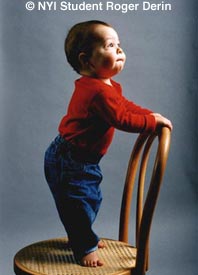New York City professional photographer Richard Martin has accomplished many things over his career. Richard spent a decade working as an NYIP Student Advisor and still contributes articles to NYIP Photoworld and spends time on NYIP's photography forum.
But if you asked Richard about the really important things in his life, his granddaughter would be right up at the top. There are lots of articles about how to take pictures of your toddler, but here we're proud to invert that equation — put your camera in your toddler's hands! Richard gives you some ideas on what to expect.
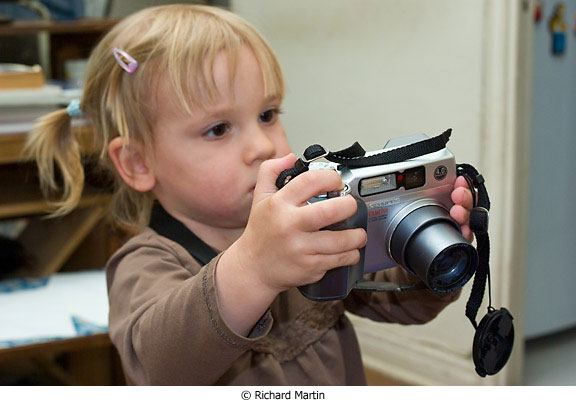 A while back I wrote an article on how to take photos of your toddler. But suppose your child wants to take pictures, perhaps of you or maybe of other things (teddy bears and similar stuffed animals come to mind). Well, you probably won't want to hand them your expensive DSLR. Way too big and heavy for little hands, not to mention the chance of damage if it's dropped. But inexpensive point-and-shoot models are widely available and might be just the ticket.
A while back I wrote an article on how to take photos of your toddler. But suppose your child wants to take pictures, perhaps of you or maybe of other things (teddy bears and similar stuffed animals come to mind). Well, you probably won't want to hand them your expensive DSLR. Way too big and heavy for little hands, not to mention the chance of damage if it's dropped. But inexpensive point-and-shoot models are widely available and might be just the ticket.
My granddaughter recently expressed an interest in taking pictures with what she refers to as "the big camera", an Olympus C4000. Toy cameras that didn't do anything now bored her. This Olympus model was my first digital, purchased primarily so that I could teach myself something about this technology without mortgaging the house, a DSLR being quite beyond my budget at that time. It is equipped with a 4MP sensor and plenty of features like Aperture and Shutter Priority. Naturally it is no longer manufactured. In fact, all three of my other Olympus cameras (two C5050's and a C8080) have been long discontinued but no matter. Just because something has been discontinued doesn't mean it's now no good. But I digress.
I have set the camera in Auto, meaning that everything is automatic. Older children might benefit from instruction in various exposure modes and such but that's not for toddlers. After all, you are not really going to teach photography to someone at this age. A camera in the hands of a toddler is still essentially a toy to the child and the fun quotient is largely dependent on how easy it is for them to use. So Auto is the way to go.
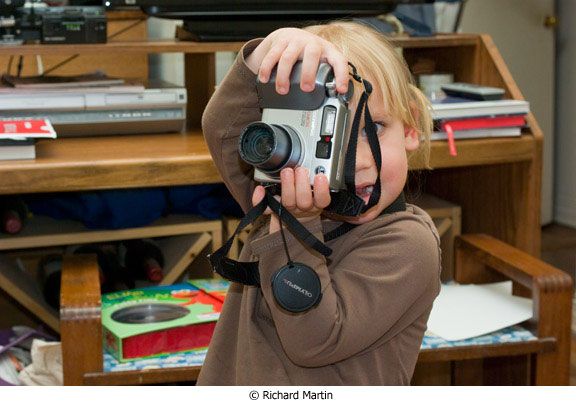
The first step, of course, is teaching them how to hold the camera. This might be trickier than it sounds because little fingers have a way of migrating to the lens. If the camera is the type whose lens extends out from the body when turned on, your child might try to turn the camera off by pushing the lens in with his/her fingers. That could strip the mechanism's little plastic gears. Be warned. Also, those fingers might want to explore the buttons on the camera. This is where a camera that has few direct controls might be the best choice. But which model? Here the choices are quite abundant in spite of some reports that manufacturers are slowly abandoning point-and-shoots.
First there are the cameras designed specifically for children. You generally don't have to worry about buttons. Except for the shutter release button, there are few on the most basic models. They are easy to use and usually come in an "attractive" color design. However, the resulting images are generally poor in quality though a toddler won't notice that. And some are a bit heavy and bulky for small hands. As for tech help, it's typically non-existent.
But there are two big downsides to such models. One, they sometimes stop working soon after purchase (or are dead-on-arrival). Read the customer reviews and you'll see what I mean. Nothing disappoints a child more than a new toy that doesn't work. Two, there is little room for the child to "grow" with the camera when they get older. However, I don't consider that too much of a problem because these cameras are essentially throwaway models. And considering the fact that they will certainly be dropped, it's a good thing they are cheap. How cheap? Well, I would consider $100 US to be the absolute maximum you would want to spend on these things, preferably less.
The Vtech Kidizoom is typical. It's 2 megapixels, has a double-eye optical viewfinder that probably helps line up the shots. Has internal memory but you can add an SD card. It even features some games and is available in several color schemes.
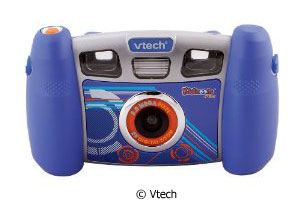
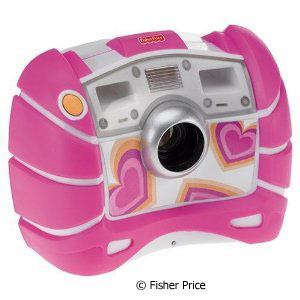
Fisher Price manufactures similar models called "kid tough". One advertisement I saw online listed blue ones for boys and pink ones for girls.
I'm not making any specific recommendations regarding these toys (and they are toys) because I don't think it makes much difference which model you buy. So let's move on. How about beginner cameras aimed at the adult market? Here we're moving up in class a bit. Many of these lack optical viewfinders nowadays but do have larger LCD screens than those in the past. Also, they use removable memory cards (typically SD) though you'll almost certainly have to buy that separately. 10 megapixels or so is the norm, at least as of this writing. Some feature more but bear in mind that more pixels with the tiny sensors these cameras are equipped with means greater noise. I consider 10MP to be the practical limit here. Most of those I've looked at use AA batteries, nice since these are widely available, but some require a proprietary lithium-ion. Not so easily obtained and while they are rechargeable, sometimes you have to pay extra for a charger. Here's a representative sample of models:
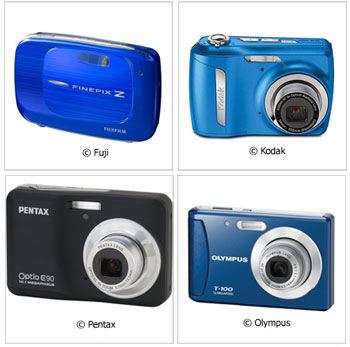
- Fuji FinePix Z37
- Kodak EasyShare C142
- Pentax Optio E90
- Olympus T-100
All are currently priced at under $100 US, not including memory card, extra batteries, and anything you decide to buy as accessories, like a case.
But suppose you are like me and have an old point-and-shoot model you don't use anymore. Well, the only way to determine if it's suitable for your toddler is to let the child try it. My granddaughter had a lot of fun with my Olympus but framing proved to be somewhat difficult, with lots of shots of the rug, my shoes, and the furniture. Eventually she got the idea that what she saw on the LCD screen was what the camera captured. However, she has seen me shoot with my DSLR by holding the camera up to my eye, using the optical viewfinder, so naturally she tried to do the same. You know kids. But learning to actually frame the shot that way rather than simply holding the camera up to her face was another matter. Still, framing with the LCD screen will probably be easier. All point-and-shoot models offer what on modern DSLR's is called "live view".
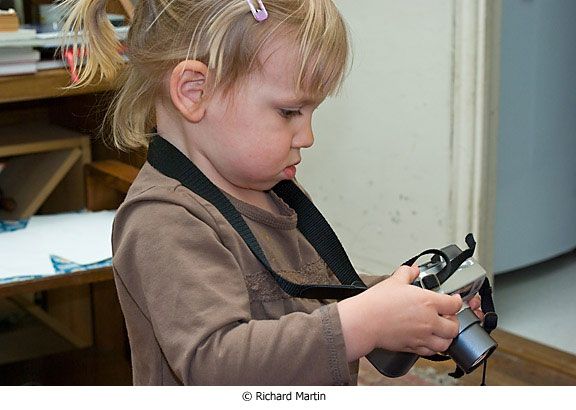
Ok, so your little one has banged off a bunch of images; maybe even filled up the memory card. Now what? Well, it's time to view the images on a larger screen (your computer being the obvious choice) so both of you can see them more comfortably. Don't be too quick to delete shots you would normally consign to the trash. Let your child see everything. Images that are tilted can be fixed in Photoshop but I wouldn't bother. Who says horizons have to be straight? Heads cut off? Fine. Think of it as a way of seeing people through a child's eyes. Shots of the family pet whose nose appears unnaturally huge, the result of being too close to the subject? Great. Same story as with people. With time and practice your child will learn why we usually want horizons straight (but not always), why cutting off heads is funny but not really acceptable, and why we normally try to avoid that notorious "dog's nose". But not in the beginning.

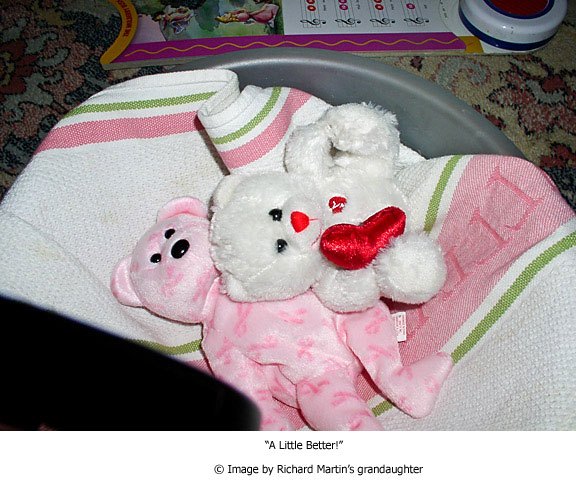
The bottom line is simply this: taking pictures should be fun and educational at the same time but with the emphasis on FUN. Don't be a strict and harsh "schoolmaster". Relax and you'll enjoy it as much as your child does.



